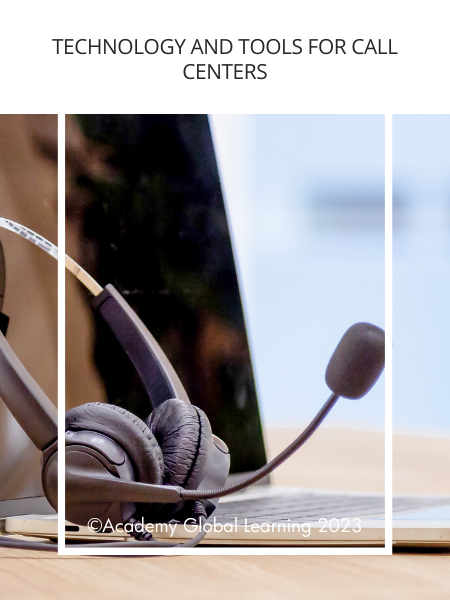

This book developed by ©Academy Global Learning 2024
All rights reserved under ©Academy Global Learning 2024. No part of this publication may be reproduced, stored in a retrieval system, or transmitted in any form or by any means, electronic, mechanical, photocopying, recording, or otherwise, without the prior written permission of the copyright owner.
Designed By:
Christian Alas
Created and illustrated By:
Angelo Romero

Handling Complaints and Difficult Customers
One of the most challenging aspects of customer service is dealing with complaints and difficult customers. However, these situations can also be opportunities to build trust, loyalty, and a stronger relationship with the customer. The ability to handle complaints effectively can turn a negative experience into a positive one, potentially converting an unhappy customer into a long-term supporter of the business.

– 2 –
Techniques to Diffuse Tense Situations
When customers are upset, it is essential to remain calm and composed. Customers often express their dissatisfaction because they feel their concerns aren’t being heard, or they believe their problem is not being taken seriously. Your role as a call center agent is to listen, empathize, and find a way to resolve the issue.
1. A cknowledge the Issue: Begin by acknowledging the customer’s frustration. Saying something like, “I understand how frustrating this must be” or “I’m sorry to hear about the issue you’re experiencing” helps to validate the customer’s feelings.
2. Stay Calm and Professional: Even if the customer becomes rude or aggressive, maintain your professionalism. Take a deep breath and respond with a calm and reassuring tone. Remember, your goal is to solve the problem, not escalate the conflict.
3. Avoid Blame: Never blame the customer or anyone else for the issue. Instead, focus on finding a solution. Phrases like, “I’m sorry that happened. Let’s see how we can make it right,” shift the focus to resolution.
4. Apologize and Offer Solutions: Apologizing for the inconvenience doesn’t necessarily mean admitting fault—it means expressing empathy. Once the problem is understood, offer a practical solution. If the solution requires time or multiple steps, keep the customer informed about what will happen next.
– 3 –
5. Offer Compensation (When Appropriate): If the situation warrants it and the company’s policies allow it, offering compensation (such as a discount or free service) may help to mitigate the situation and show the customer that you value their business.
Turning Complaints into Opportunities
A complaint is not only an opportunity to resolve an issue but also a chance to enhance the customer’s experience. If handled well, complaints can lead to higher customer loyalty. Customers are more likely to return to a business where they feel their concerns are taken seriously and resolved promptly.
Here’s how to turn complaints into opportunities:
1. Resolve the Issue Quickly: The faster you can find a resolution, the better the customer will feel. A quick response shows the customer that their issue is a priority.
2. Follow Up: After resolving the issue, following up with the customer ensures they are satisfied with the outcome. It also shows that the company is committed to providing excellent customer service, even after the initial interaction.
3. Gather Feedback: Use the opportunity to ask for feedback on how the situation was handled. This shows the customer that their input matters and helps you improve your service.
– 4 –
Activity: Role-Play Handling a Dissatisfied Customer
In this activity, you will participate in a role-playing exercise with a partner. One person will take on the role of an upset customer, while the other will practice handling the complaint using the techniques discussed. Afterward, you will reflect on what worked well and what could be improved in handling the difficult customer.
Key Takeaways:
• Handling complaints with empathy, patience, and professionalism can turn a dissatisfied customer into a loyal one.
• Offering timely solutions and following up with customers after a complaint shows dedication to customer satisfaction.
• Complaints are opportunities to enhance customer loyalty and improve service processes.

– 5 –



 ESL for call centers | Introduction to Customer Service: The Cornerstone of Business Success
ESL for call centers | Introduction to Customer Service: The Cornerstone of Business Success  ESL for call centers | Building Customer Relationships
ESL for call centers | Building Customer Relationships  ESL for call centers | Problem-Solving in Customer Service
ESL for call centers | Problem-Solving in Customer Service  ESL for call centers | Technology and Tools for Call Centers
ESL for call centers | Technology and Tools for Call Centers  ESL for call centers | Professional Development and Career Growth
ESL for call centers | Professional Development and Career Growth  ESL for call centers | Self-Care and Stress Management
ESL for call centers | Self-Care and Stress Management  ESL for call centers | Practice Active Listening and Clear Communication Techniques
ESL for call centers | Practice Active Listening and Clear Communication Techniques  ESL for call centers | Professionalism in the Call Center
ESL for call centers | Professionalism in the Call Center